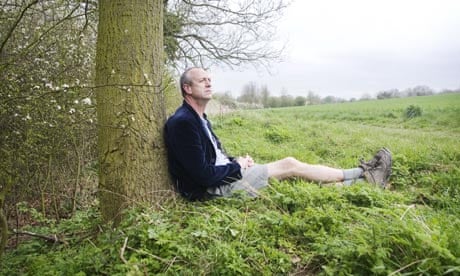A thing of quiet beauty

Arthur Smith takes Gainsborough's cue and explores the gentle curves and hollows around the Suffolk town of Sudbury
As your man from the Guardian rang me to ask if I’d introduce this week of walking guides, I was already mentally prising my eager feet into my crusty boots, but when he added that I would be strolling through Gainsborough country, around the Suffolk town of Sudbury, I felt like the economy – somewhat deflated.
I’ve been trekking the hills and lanes of the British countryside for nearly four decades now and I’ve come to associate my passion with overexcited poets rather than pampered painters. The Romantic poets were the prototype ramblers, and I’ve often found myself following in their footsteps – although perhaps not all of their footsteps since a typical walk for Samuel T Coleridge might last two days and cover 145km. Coleridge, Wordsworth and their gang famously poeticised the Lake District, where the dramatic contours, jagged shadows and rocky terrain suited their temperaments, but they also roamed the West Country and the Downs of south-east England (Keats wrote Endymion on Box Hill near Dorking). On the subject of the eastern hump of England, however, where there are no “black chasms, and dizzy crags”, the Romantics have nothing much to say.
Describing the Suffolk countryside demands a subdued vocabulary, liable to include adjectives like “subtle”, “gentle” and, of course, “flat”. For a certain breed of rambler, “flat” equals boring – a good view needs height just as a decent walk requires that you get out of breath, struggling uphill. It is not surprising, then, that Suffolk and Norfolk rarely attract the attention of the striding wanderer.
But a day out in the delicate Suffolk folds, I suddenly remembered, can, if you are too complacent, be as demanding as a march up a sweaty northern mountain. The only one of all my walks where I needed the attentions of a man with a big torch was near Walberswick, about 50km north of Sudbury. That said, unless you become even more lost and late than usual, you are unlikely to need the number of the Suffolk mountain rescue team.
The undulations of the land may not be as physically demanding as those of Cumbria, but this is the corner of England that, half a century before the Romantics, inspired works by Constable and Gainsborough, two of the best loved English landscape painters.
The train from Marks Tey takes you along the leafy Stour valley and passes over the mighty Chappel viaduct before arriving in Sudbury. The Gainsborough Line, as this is called, is a tribute to the little town’s most famous ex-resident and, after a bossily signed kilometre or two, you are soon marching past ponds and along paths that look familiar from the jigsaws and biscuit tins of your youth – Gainsborough and Constable have shifted a heap of merchandise over the years.
You get a lot of sky for your money in these parts, and sky is a big challenge for all artists. In the book I bought about Gainsborough, Hugh Belsey writes of A Wooded Landscape with Herdsman Seated: “The effect of the painting depends on the tranquil cloudscape that mottles the landscape beneath with pools of sunlight.”
Sky and clouds and trees and little figures relaxing in the perfect rural rhythm of their surroundings: these are the staples of a Gainsborough landscape. After 6km I sat under a tree and let the minimalism of my surroundings slow my mind. I remembered my days as a cross-country runner in Norfolk and the punishing effort of traversing huge, wet, ploughed-up fields, and then I sat some more. Although there are fewer herdsmen, peasants, milkmaids and packhorses than in Gainsborough’s day, the subtle curves of the land and the angular trees of his images are still in evidence. The titles of his paintings and sketches serve as a description of what you see on your amble through Suffolk: Landscape with Figures, Cottages and Cow; Study of a Wooded Landscape with Country Lane; A Pathway through a Landscape with a Farm in the Distance.
“The landscape of Gainsborough,” wrote Constable, “is soothing, tender and affecting,” and so is this walk, which you should round off with a tour of the Gainsborough museum, the large, elegant house in Sudbury that contains all the pictures mentioned above, as well as copies of the Belsey book. You can indulge a little 18th-century hour or look at one of the contemporary exhibitions the museum also puts on. I was welcomed grandly to the house by a charming and formidable trio of ladies, one of whom will dress up as Mrs Gainsborough if you ask her nicely.
Have a look round the pretty garden and its 200-year-old mulberry tree, which resembles a huge, grounded octopus, and then take five, have a cup of tea, enjoy the touch of weariness in your legs, dream a gentle pastoral dream, and be suffused with Suffolk.
• Arthur Smith walked route 1702 (The home of Gainsborough), an “easy” 12km.

